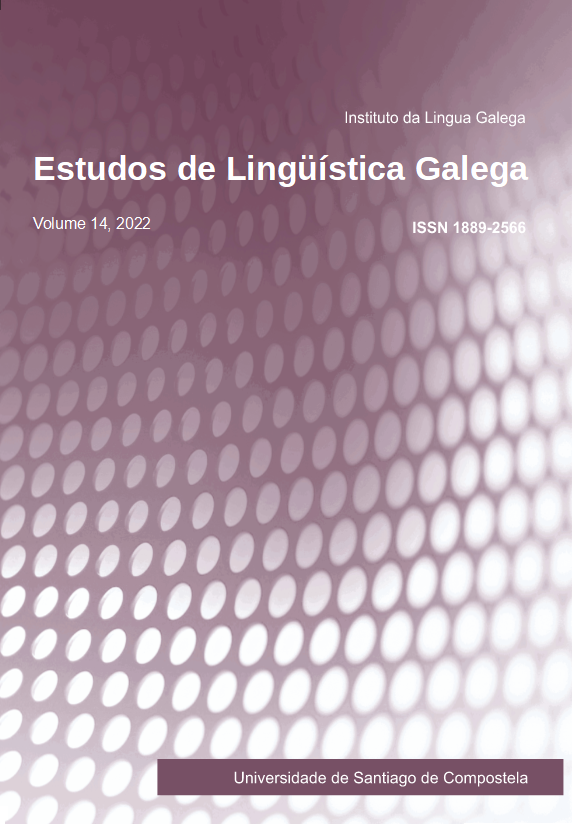Vowel Harmony and Metaphony in Iberia: A Revised Analysis
Main Article Content
Abstract
The present article seeks to describe and account for the phenomenon of metaphony, as observed in the north of the Iberian Peninsula, within the context of a description of the vowel harmony observable in other languages of the world. Two features are shown to participate in Northern Iberian vowel harmony, namely tongue-height and centralization, both triggered by word-fi nal /ɨ/ and /ʉ/. Diachronic and diatopic accounts of the phenomena concerned here are followed by discussion of the morphological and semantic features that are associated with Hispanic metaphony. Finally, a comparison is made with the metaphony observable in Galicia, Portugal, and Italy. In conclusion, it is speculated that metaphony was a feature of the earliest Roman settlers of Spain, who came predominantly from areas of Italy where metaphony is strongly established today.
Keywords:
Article Details
References
Alonso, Dámaso (1962): “Sobre el vocalismo portugués y castellano (con motivo de una teoría)”, in Manuel Alvar et al. (eds.), Enciclopedia Lingüística Hispánica, I: La fragmentación fonética peninsular, vol. 1 (supplement). Madrid: CSIC, 5-21.
Álvarez Blanco, Rosario (1988): “Consideracións sobre a metafonía nominal galega”, in Dieter Kremer (ed.), Homenagem a Joseph M. Piel por ocasião do seu 85.o aniversario. Tübingen: Niemeyer, 141-158.
Fernández-Ordóñez, Inés (1994): “Isoglosas internas del castellano: el sistema referencial del pronombre átono de tercera persona”, Revista de Filología Española 74, 71-125.
Fernández-Ordóñez, Inés (1999): “Leísmo, laísmo y loísmo”, in Ignacio Bosque / Violeta Demonte (eds.), Gramática descriptiva de la lengua española. Madrid: Real Academia Española / Espasa Calpe (Colección ‘Nebrija y Bello’), 1317-1397.
Goldsmith, John (1987): “Vowel systems”, Chicago Linguistic Society 23:2, 116-133.
Hall, Robert A. Jr. (1968): “Neuters, Mass-Nouns and the Ablative in Romance”, Language 44, 480- 86.
Hualde, José Ignacio (1989): “Autosegmental and Metrical Spreading in the Vowel-Harmony Systems of Northwestern Spain”, Linguistics 27/5, 773-805.
Laver, John (1994): Principles of Phonetics. Cambridge: Cambridge University Press (Cambridge Textbooks in Linguistics).
Linguistic Atlas of the Iberian Peninsula: ALPI searchable database, at www.alpi.ca
Maiden, Martin (1985-86): “Displaced Metaphony and the Morphologization of Metaphony”, Romance Philology 39, 22-34.
Maiden, Martin (1987): “New perspectives on the Genesis of Italian Metaphony”, Transactions of the Philological Society 85/1, 38-73.
McCarthy, John (1984): ‘Theoretical Consequences of Montañés Vowel Harmony’, Linguistic Inquiry 15, 291-318.
Navarro Tomás, Tomás (ed.) (1962): Atlas lingüístico de la Península Ibérica, I, Fonética, 1. Madrid: CSIC.
Penny, Ralph J. (1969a): El habla pasiega: ensayo de dialectología montañesa. London: Tamesis.
Penny, Ralph J. (1969b): “Vowel-Harmony in the Speech of the Montes de Pas (Santander)”, Orbis 18, 148-166.
Penny, Ralph J. (1970): “Mass Nouns and Metaphony in the Dialects of Northwestern Spain”, Archivum Linguisticum, n.s., 1, 21-30.
Penny, Ralph J. (1992-93): “Final /e/ in Asturian Feminine Singulars: Another Mass-Noun Marker?”, Journal of Hispanic Research 1, 183-86.
Penny, Ralph J. (1994): “Continuity and Innovation in Romance: Metaphony and Mass-Noun Reference in Spain and Italy”, Modern Language Review 89, 273-281.
Penny, Ralph J. (2000): Variation and Change in Spanish. Cambridge: Cambridge University Press, 98-103.
Picard, Marc (2001) “Vowel Harmony, Centralization, and Peripherality: The Case of Pasiego”, Linguistics 39, 117-32.
Politzer, Robert (1957): “Masculine and Neuter in South-Central Italian”, Word 13, 441-446.
Porto Dapena, J. A. (1973): “Alternancias vocálicas en los nombres y verbos gallego-portugueses: un intento de explicación histórica”, Thesaurus. Boletín del Instituto Caro y Cuervo 28, 526-544.
Rodríguez-Castellano, Lorenzo (1952): La variedad dialectal del Alto Aller. Oviedo: Instituto de Estudios Asturianos.
Spencer, Andrew (1986): “Vowel Harmony, Neutral Vowels and Autosegmental Theory”, Lingua 69, 3-21.
Tuttle, Edward F. (1985-86): “Morphologization as Redundancy in Central Italian Dialects”, Romance Philology 39, 35-43.
Vago, Robert (1988): “Underspecification Theory in the Dual Harmony System of Pasiego (Spanish)”, Phonology 5/2, 343-362.
Wilson, Tom (1988): “Blocking and Repair in Pasiego Vowel Harmony”, Toronto Working Papers in Linguistics 9, 141-171.


